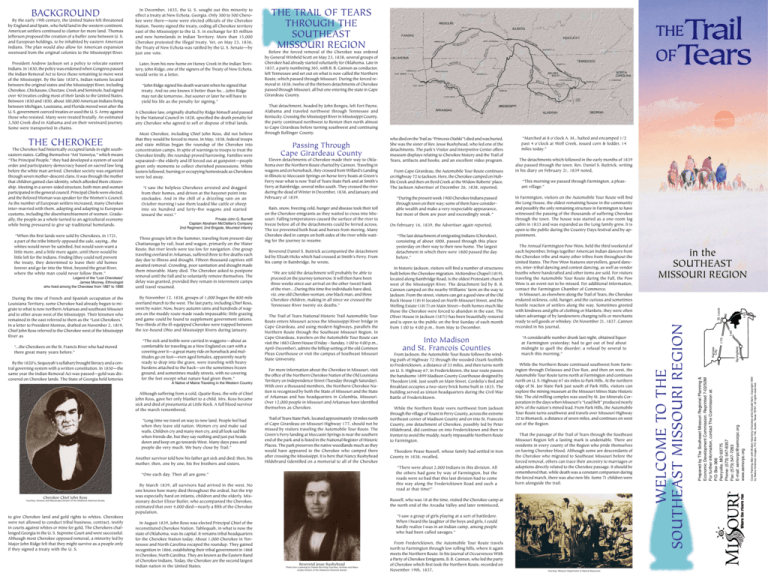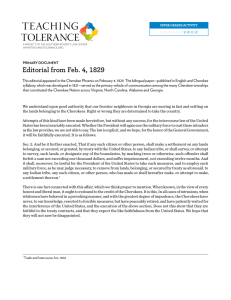
By the 1820’s, Sequoyah’s syllabary brought literacy and a central governing system with a written constitution. In 1830—the
same year the Indian Removal Act was passed—gold was discovered on Cherokee lands. The State of Georgia held lotteries
Private John G. Burnett
Captain Abraham McClellan’s Company
2nd Regiment, 2nd Brigade, Mounted Infantry
Three groups left in the Summer, traveling from present-day
Chattanooga by rail, boat and wagon, primarily on the Water
Route. But river levels were too low for navigation. One group
traveling overland in Arkansas, suffered three to five deaths each
day due to illness and drought. Fifteen thousand captives still
awaited removal. Crowding, poor sanitation and drought made
them miserable. Many died. The Cherokee asked to postpone
removal until the Fall and to voluntarily remove themselves. The
delay was granted, provided they remain in internment camps
until travel resumed.
By November 12, 1838, groups of 1,000 began the 800 mile
overland march to the west. The last party, including Chief Ross,
went by water. Now, heavy autumn rains and hundreds of wagons on the muddy route made roads impassable; little grazing
and game could be found to supplement government rations.
Two-thirds of the ill-equipped Cherokee were trapped between
the ice-bound Ohio and Mississippi Rivers during January.
“The sick and feeble were carried in waggons—about as
comfortable for traveling as a New England ox cart with a
covering over it—a great many ride on horseback and multitudes go on foot—even aged females, apparently nearly
ready to drop into the grave, were traveling with heavy
burdens attached to the back—on the sometimes frozen
ground, and sometimes muddy streets, with no covering
for the feet except what nature had given them.”
A Native of Maine Traveling in the Western Country
Although suffering from a cold, Quatie Ross, the wife of Chief
John Ross, gave her only blanket to a child. Mrs. Ross became
sick and died of pneumonia at Little Rock. A full blood survivor
of the march remembered,
“Long time we travel on way to new land. People feel bad
when they leave old nation. Women cry and make sad
wails. Children cry and many men cry, and all look sad like
when friends die, but they say nothing and just put heads
down and keep on go towards West. Many days pass and
people die very much. We bury close by Trail.”
Another survivor told how his father got sick and died; then, his
mother; then, one by one, his five brothers and sisters.
Rain, snow, freezing cold, hunger and disease took their toll
on the Cherokee emigrants as they waited to cross into Missouri. Falling temperatures caused the surface of the river to
freeze before all of the detachments could be ferried across.
The ice prevented both boat and horses from moving. Many
Cherokee died in camps on both sides of the river while waiting for the journey to resume.
Reverend Daniel S. Buttrick accompanied the detachment
led by Elizah Hicks which had crossed at Smith’s Ferry. From
his camp in Bainbridge, he wrote,
“We are told the detachment will probably be able to
proceed on the journey tomorrow. It will then have been
three weeks since our arrival on the other (west) bank
of the river....During this time five individuals have died,
viz. one old Cherokee woman, one black man, and three
Cherokee children, making in all since we crossed the
Tennessee River twenty six deaths.”
The Trail of Tears National Historic Trail Automobile Tour
Route enters Missouri across the Mississippi River bridge in
Cape Girardeau, and using modern highways, parallels the
Northern Route through the Southeast Missouri Region. In
Cape Girardeau, travelers on the Automobile Tour Route can
visit the 1883 Glenn House (Friday - Sunday, 1:00 to 4:00 p.m.,
April-December), admire the hilltop setting of the old Common
Pleas Courthouse or visit the campus of Southeast Missouri
State University.
For more information about the Cherokee in Missouri, visit
the office of the Northern Cherokee Nation of the Old Louisiana
Territory on Independence Street (Tuesday through Saturday).
With over a thousand members, the Northern Cherokee Nation is recognized by both the State of Missouri and the State
of Arkansas and has headquarters in Columbia, Missouri.
Over 12,000 people in Missouri and Arkansas have identified
themselves as Cherokee.
Trail of Tears State Park, located approximately 10 miles north
of Cape Girardeau on Missouri Highway 177, should not be
missed by visitors traveling the Automobile Tour Route. The
Green’s Ferry landing at Moccasin Springs is near the southern
end of the park and is listed in the National Register of Historic
Places. The park preserves the native woodlands much as they
would have appeared to the Cherokee who camped there
after crossing the Mississippi. It is here that Nancy Bushyhead
Hildebrand (identified on a memorial to all of the Cherokee
Cherokee Chief John Ross
to give Cherokee land and gold rights to whites. Cherokees
were not allowed to conduct tribal business, contract, testify
in courts against whites or mine for gold. The Cherokees challenged Georgia in the U. S. Supreme Court and were successful.
Although most Cherokee opposed removal, a minority led by
Major John Ridge felt that they might survive as a people only
if they signed a treaty with the U. S.
By March 1839, all survivors had arrived in the west. No
one knows how many died throughout the ordeal, but the trip
was especially hard on infants, children and the elderly. Missionary doctor Elizur Butler, who accompanied the Cherokee,
estimated that over 4,000 died—nearly a fifth of the Cherokee
population.
In August 1839, John Ross was elected Principal Chief of the
reconstituted Cherokee Nation. Tahlequah, in what is now the
state of Oklahoma, was its capital. It remains tribal headquarters
for the Cherokee Nation today. About 1,000 Cherokee in Tennessee and North Carolina escaped the roundup. They gained
recognition in 1866, establishing their tribal government in 1868
in Cherokee, North Carolina. They are known as the Eastern Band
of Cherokee Indians. Today, the Cherokee are the second largest
Indian nation in the United States.
“During the present week 1900 Cherokee Indians passed
through town on their way; some of them have considerable wealth and make a very respectable appearance,
but most of them are poor and exceedingly weak.”
On February 16, 1839, the Advertiser again reported,
“The last detachment of emigrating Indians (Cherokee),
consisting of about 1000, passed through this place
yesterday on their way to their new home. The largest
detachment in which there were 1800 passed the day
before.”
In historic Jackson, visitors will find a number of structures
built before the Cherokee migration. McKendree Chapel (1819),
located along Bainbridge Road, is the oldest Protestant church
west of the Mississippi River. The detachment led by B. B.
Cannon camped on the nearby Williams’ farm on the way to
Jackson. From the street, visitors can get a good view of the Old
Rock House (1814) located on North Missouri Street, and the
Welling Estate (1817) on Main Street—both homes much like
those the Cherokee were forced to abandon in the east. The
Oliver House in Jackson (1871) has been beautifully restored
and is open to the public on the first Sunday of each month
from 1:00 to 4:00 p.m., from May to December.
Into Madison
and St. Francois Counties
From Jackson, the Automobile Tour Route follows the winding path of Highway 72 through the wooded Ozark foothills
to Fredericktown, a distance of 33 miles, and then turns north
on U. S. Highway 67. In Fredericktown, the tour route passes
the handsome 1899 Madison County Courthouse designed by
Theodore Link. Just south on Main Street, Cordelia’s Bed and
Breakfast occupies a two-story brick home built in 1835. The
building served as Union headquarters during the Civil War
Battle of Fredericktown.
While the Northern Route veers northwest from Jackson
through the village of Yount in Perry County, across the extreme
northeast corner of Madison County and on into St. Francois
County, one detachment of Cherokee, possibly led by Peter
Hildebrand, did continue on into Fredericktown and then to
Ironton to avoid the muddy, nearly impassable Northern Route
to Farmington.
Theodore Pease Russell, whose family had settled in Iron
County in 1838, recalled,
“There were about 2,000 Indians in this division. All
the others had gone by way of Farmington, but the
roads were so bad that this last division had to come
this way along the Fredericktown Road and such a
road at that time!”
“One each day. Then all are gone.”
Courtesy: Archives and Manuscripts Division of the Oklahoma Historical Society
From Cape Girardeau, the Automobile Tour Route continues
on Highway 72 to Jackson. Here, the Cherokee camped on Hubble Creek and then on Byrd Creek at the Widow Roberts’ place.
The Jackson Advertiser of December 26, 1838, reported,
The detachments which followed in the early months of 1839
also passed through the town. Rev. Daniel S. Buttrick, writing
in his diary on February 21, 1839 noted,
“This morning we passed through Farmington, a pleasant village.”
In Farmington, visitors on the Automobile Tour Route will find
the Long House, the oldest remaining house in the community
and possibly the only remaining structure in Farmington to have
witnessed the passing of the thousands of suffering Cherokee
through the town. The house was started as a one-room log
cabin in 1833 and was expanded as the Long family grew. It is
open to the public during the Country Days festival and by appointment.
The Annual Farmington Pow Wow, held the third weekend of
each September, brings together American Indian dancers from
the Cherokee tribe and many other tribes from throughout the
United States. The Pow Wow features storytellers, gourd dancers, inter-tribal dancing and contest dancing, as well as vendor
booths where handcrafted and other items are sold. For visitors
traveling the Automobile Tour Route during the Fall, the Pow
Wow is an event not to be missed. For additional information,
contact the Farmington Chamber of Commerce.
In Missouri, as elsewhere along the Trail of Tears, the Cherokee
endured sickness, cold, hunger, and the curious and sometimes
hostile reaction of settlers along the way. Sometimes greeted
with kindness and gifts of clothing or blankets, they were often
taken advantage of by landowners charging tolls or merchants
ready to sell goods or whiskey. On November 21, 1837, Cannon
recorded in his journal,
“A considerable number drunk last night, obtained liquor
at Farmington yesterday; had to get out of bed about
midnight to quell the disorder; a refusal by several to
march this morning.”
While the Northern Route continued southwest from Farmington through Delassus and Doe Run, and then on west, the
Automobile Tour Route turns north at Farmington and continues
north on U. S. Highway 67 six miles to Park Hills. At the northern
edge of St. Joe State Park just south of Park Hills, visitors can
explore the mining museum at the Missouri Mines State Historic
Site. The old milling complex was used by St. Joe Minerals Corporation in the days when Missouri’s “Lead Belt” produced nearly
80% of the nation’s mined lead. From Park Hills, the Automobile
Tour Route turns southwest and travels over Missouri Highway
32 to Bismarck, a distance of seven miles, and continues on west
out of the Region.
That the passage of the Trail of Tears through the Southeast
Missouri Region left a lasting mark is undeniable. There are
residents in every county of the Region who pride themselves
on having Cherokee blood. Although some are descendants of
the Cherokee who migrated to Southeast Missouri before the
forced removal, others can trace their ancestry to marriages or
adoptions directly related to the Cherokee passage. It should be
remembered that, while death was a constant companion during
the forced march, there was also new life. Some 71 children were
born alongside the trail.
Russell, who was 18 at the time, visited the Cherokee camp at
the north end of the Arcadia Valley and later reminisced,
“I saw a group of girls playing at a sort of battledore.
When I heard the laughter of the boys and girls, I could
hardly realize I was in an Indian camp, among people
who had been called savages.”
Reverend Jesse Bushyhead
Photo from a painting by Charles Bird King (Courtesy: Archives and Manuscripts Division of the Oklahoma Historical Society
From Fredericktown, the Automobile Tour Route travels
north to Farmington through low rolling hills, where it again
meets the Northern Route. In his Journal of Occurrences With
a Party of Cherokee Emigrants, B. B. Cannon, who led the party
of Cherokee which first took the Northern Route, recorded on
November 19th, 1837,
Courtesy: Missouri Department of Natural Resources
in the
SOUTHEAST
MISSOURI REGION
Cover Painting: Men with Broken Hearts by Cherokee artist Donald Vann, Copyright 1994
by Native American Images, P.O. Box 746, Austin, Texas 78767, all rights reserved.
“...the Cherokees on the St. Francis River who had moved
there great many years before.”
Eleven detachments of Cherokee made their way to Oklahoma over the Northern Route charted by Cannon. Traveling in
wagons and on horseback, they crossed from Willard’s Landing
in Illinois to Moccasin Springs on horse ferry boats at Green’s
Ferry near what is now Trail of Tears State Park and at Smith’s
Ferry at Bainbridge, several miles south. They crossed the river
during the dead of Winter in December, 1838, and January and
February of 1839.
“Marched at 8 o’clock A. M., halted and encamped 1/2
past 4 o’clock at Wolf Creek, issued corn & fodder, 14
miles today.”
I-55
During the time of French and Spanish occupation of the
Louisiana Territory, some Cherokee had already begun to migrate to what is now northern Arkansas and southeast Missouri
and to other areas west of the Mississippi. Their kinsmen who
remained in the east referred to them as the “Lost Cherokees.”
In a letter to President Monroe, drafted on November 2, 1819,
Chief John Ross referred to the Cherokee west of the Mississippi
River as
“I saw the helpless Cherokees arrested and dragged
from their homes, and driven at the bayonet point into
stockades. And in the chill of a drizzling rain on an
October morning I saw them loaded like cattle or sheep
into six hundred and forty-five wagons and started
toward the west.”
Passing Through
Cape Girardeau County
who died on the Trail as “Princess Otahki”) died and was buried.
She was the sister of Rev. Jesse Bushyhead, who led one of the
detachments. The park’s Visitor and Interpretive Center offers
museum displays relating to Cherokee history and the Trail of
Tears, artifacts and books, and an excellent video program.
I-44
Legend of the “Lost Cherokees”
James Mooney, Ethnologist
who lived among the Cherokee from 1887 to 1890
Most Cherokee, including Chief John Ross, did not believe
that they would be forced to move. In May, 1838, federal troops
and state militias began the roundup of the Cherokee into
concentration camps. In spite of warnings to troops to treat the
Cherokee kindly, the roundup proved harrowing. Families were
separated—the elderly and ill forced out at gunpoint—people
given only moments to collect cherished possessions. White
looters followed, burning or occupying homesteads as Cherokees
were led away.
Springfield
A Cherokee law, originally drafted by Ridge himself and passed
by the National Council in 1828, specified the death penalty for
any Cherokee who agreed to sell or dispose of tribal lands.
That detachment, headed by John Benges, left Fort Payne,
Alabama and traveled northwest through Tennessee and
Kentucky. Crossing the Mississippi River in Mississippi County,
the party continued northwest to Benton then north almost
to Cape Girardeau before turning southwest and continuing
through Bollinger County.
St. Louis
“When the first lands were sold by Cherokees, in 1721,
a part of the tribe bitterly opposed the sale, saying...the
whites would never be satisfied, but would soon want a
little more, and a little more again, until there would be
little left for the Indians. Finding [they could not] prevent
the treaty, they determined to leave their old homes
forever and go far into the West, beyond the great River,
where the white man could never follow them.”
“John Ridge signed his death warrant when he signed that
treaty. And no one knows it better than he....John Ridge
may not die tomorrow...but sooner or later he will have to
yield his life as the penalty for signing.”
I-70
THE CHEROKEE
The Cherokee had historically occupied lands in eight southeastern states. Calling themselves “Ani Yunwiya,” which means
“The Principal People,” they had developed a system of social
order and participatory democracy based on sacred law long
before the white man arrived. Cherokee society was organized
through seven mother-descent clans. It was through the mother
that children gained clan identity, which afforded them citizenship. Meeting in a seven-sided structure, both men and women
participated in the general council. Principal Chiefs were elected,
and the Beloved Woman was speaker for the Women’s Council.
As the number of European settlers increased, many Cherokee
inter-married with them, adopting and adapting to European
customs, including the disenfranchisement of women. Gradually, the people as a whole turned to an agricultural economy
while being pressured to give up traditional homelands.
Later, from his new home on Honey Creek in the Indian Territory, John Ridge, one of the signers of the Treaty of New Echota,
would write in a letter,
by General Winfield Scott on May 23, 1838, several groups of
Cherokee had already started voluntarily for Oklahoma. Late in
1837, a party numbering 365, with B. B. Cannon as conductor,
left Tennessee and set out on what is now called the Northern
Route, which passed through Missouri. During the forced removal in 1838, twelve of the thirteen detachments of Cherokee
passed through Missouri, all but one entering the state in Cape
Girardeau County.
Kansas
City
President Andrew Jackson set a policy to relocate eastern
Indians. In 1830, the policy was endorsed when Congress passed
the Indian Removal Act to force those remaining to move west
of the Mississippi. By the late 1830’s, Indian nations located
between the original states and the Mississippi River, including
Cherokee, Chickasaw, Choctaw, Creek and Seminole, had signed
over 40 treaties ceding most of their lands to the United States.
Between 1830 and 1850, about 100,000 American Indians living
between Michigan, Louisiana, and Florida moved west after the
U. S. government coerced treaties or used the U. S. Army against
those who resisted. Many were treated brutally. An estimated
3,500 Creek died in Alabama and on their westward journey.
Some were transported in chains.
THE TRAIL OF TEARS
THROUGH THE
SOUTHEAST
MISSOURI REGION
Before the forced removal of the Cherokee was ordered
Prepared by The Southeast Missouri Regional Planning &
Economic Development Commission. Reprinted 7-02/50M
For further information, contact The Commission at:
P.O. Box 366
Perryville, MO 63775
Phone: (573) 547-8357
Fax: (573) 547-7283
E-mail: semorpc@semorpc.org
www.semorpc.org
by England and Spain, who held land in the western continent.
American settlers continued to clamor for more land. Thomas
Jefferson proposed the creation of a buffer zone between U. S.
and European holdings, to be inhabited by eastern American
Indians. The plan would also allow for American expansion
westward from the original colonies to the Mississippi River.
In December, 1835, the U. S. sought out this minority to
effect a treaty at New Echota, Georgia. Only 300 to 500 Cherokee were there—none were elected officials of the Cherokee
Nation. Twenty signed the treaty, ceding all Cherokee territory
east of the Mississippi to the U. S. in exchange for $5 million
and new homelands in Indian Territory. More than 15,000
Cherokee protested the illegal treaty. Yet, on May 23, 1836,
the Treaty of New Echota was ratified by the U. S. Senate—by
just one vote.
Welcome to the
Southeast Missouri Region
BACKGROUND
By the early 19th century, the United States felt threatened
M
I
S
S I
S
S
I
P
P
I
Bloomsdale
Charity Along the Trail of Tears, a painting by Brother Mark Elder, C.M.
Courtesy: Missouri Department of Natural Resources
B
Ste. Genevieve
Modoc Ferry
Ste.
Genevieve
IG
U.S.
61
The Book of the Lamentations of Jeremiah, by Murv Jacob
TRAIL OF TEARS
National
Historic Trail
Courtesy: Missouri Department of Natural Resources
I
V
STE.
GENEVIEVE
E
R
VER
R I
BonneTerre
47
R
32
Chester Bridge
I-55
Desloge
P
8
Missouri Mines
State Historic Site
Park
Hills
Leadwood
American Indian dancers from many tribes participate in the Annual
St. Francis River Pow Wow, held during the third weekend in September
Long
House
N
Perryville
O
R
R
D
K
T
51
OO
AP
R O U T E
B
PL
U.S.
61
Frohna
A
E
O
Biehle
J
TE
Junction City
U
Cobalt
Village
T O
M O B I L E
72
RIVE R
72
GIRARDEAU
Pocahontas
E
O
U
T
A
177
BB
V
Marquand
OR
A
ST
. F R ANC
IS
177
34
E
C
PP
Oliver
House
OO
K
34
25
CR E E K
Des Arc
A
34
A traveler who witnessed a passing mother holding her dying
child wrote,
N
B E
G
R
O
E
T
Zalma
V
DI
ER
NORTHERN ROUTE
N
SIO
AUTOMOBILE TOUR ROUTE
2
0
S C A L E
Sequoya holding the Cherokee syllabry.
Reproduction from an original painting by
Charles Bank Wilson in the Oklahoma State
Capital
Courtesy: Missouri Department of Natural Resources
EL
Delta
51
He continued,
CH
N
AN
25
Allenville
E
U T
Southeast Missouri
State University
Common Pleas Courthouse
Glenn House
74
74
Whitewater
91
”She could only carry her dying child in her arms a few
miles farther, and then, she must stop in a stranger-land
and consign her much loved babe to the cold ground,
and that without pomp or ceremony, and pass on with
the multitude.”
When I past the last detachment of those suffering exiles and thought that my native countrymen had thus
expelled them from their native soil and their much
loved homes, and that too in this inclement season of
the year in all their suffering, I turned from the sight with
feelings which language cannot express and wept like
childhood then.”
A
BOLLINGER
51
E ’ S
34
Gordonville
U
Smith’s
Ferry
Girardeau
U.S.
61
R
34
Marble
Hill
Glenallen
easy victims of disease, particularly cholera and smallpox, but
even measles, whooping cough, pleurisy and dysentery. Stragglers were sometimes preyed upon by wild animals. A few of
the travelers were waylaid by frontier rogues and beaten or
murdered after they were robbed.
McKendree
Chapel
Cape
Jackson
E
49
Old Rock
House
B
RIV
ST
M
Y
Welling
Estate
72
Green’s
Ferry
V
D
51
J
Oak
Ridge
D
Annapolis
R
C
I-55
B
Sedgewickville
CR O O K
49
FF
E
U.S.
67
K
T O U R
C
U.S.
61
R
51
A
MADISON
49
A
Old
Appleton
D
TE
Madison
County
Courthouse
KK
W
J
Altenburg
A
EK
CAPE
HI
72
21
CRE
W
72
21
The detachments which left in June of 1838 found themselves
making the journey in the hottest part of the year during a
drought. Sickness and death plagued the exodus, most of it
caused by a combination of bad water, bad diet and physical exhaustion, particularly among the children. Some of the Indians
left almost naked and without shoes and refused government
clothing because they felt it would be taken as an acceptance
of being removed from their homes. Some refused government
food; others were given foodstuffs that were not normally part
of their diet, such as wheat flour, which they did not know how
to use. One military estimate of the death toll in one of the parties was put at 17.7%, with half of the dead being children.
Besides the cold, there was starvation and malnutrition.
Sometimes the funds for food were embezzled by those hired
to provide it along the route. The later detachments often
found that all of the wild game had been depleted by hunters
from the first detachments which passed through. Weakened
by the hunger and exertions of the trip, the Cherokee became
IV
Fredericktown
It is difficult to imagine the hardships which faced the people
of the Cherokee Nation who made the forced march to the
Indian Territory. They had already lost their homes and possessions. Most felt that their government would not force them
from their homes and made no plans for the long, arduous
journey. When the government roundup of Cherokees began,
many were forced from their homes with only the barest possessions.
Longtown
T
Pilot Knob
SURVIVING THE
“TRAIL OF TEARS”
Those who were forced to halt beside the frozen Mississippi
River still remembered a half-century later the hundreds of sick
and dying in wagons or lying on the frozen ground with only
the single blanket provided by the government to each Indian
for shelter from the January wind.
N
E
R
Ironton
Arcadia
Because of the heavy death toll, Chief Ross and the National
Council asked General Scott to allow the rest of the Cherokee
to wait until Fall to move, and to supervise their own removal.
General Scott approved the plan, provided that all must be on
the road by October 20. The remaining detachments which
left in the Fall—most of the exodus—met different hardships.
Unseasonably heavy rains turned the primitive roads to mud.
Wagons became mired axle or bed-deep in the muck, and the
Cherokee were repeatedly forced to manually drag the wagons
free.
R
IRON
E
Iron Mountain
Lake
Crosstown
P
H
32
Menfro
T
W
21
C
I-55
Wolf Creek
ST.
FRANCOIS
Doe Run
32
49
32
PERRY
51
M
Bismarck
Viburnum
Belgique
M
Farmington
Pow Wow
Site
Courtesy: Linda Schlichter
Lithium
U.S.
61
32
U.S.
67
32
H
144
Leadington
The removal and forced march of the Cherokee
from the southeastern United States to Indian Territory has come to be known as the Trail of Tears. In
1987, Congress acknowledged the significance of
the Trail by establishing the Trail of Tears National
Historic Trail which commemorates the forced
removal of the five civilized Indian tribes from the
east. The National Park Service administers the
Trail in cooperation with federal, state, and local
agencies; the Cherokee Nation and the Eastern
Band of Cherokee Indians; interested groups; and
private landowners.
For more information, contact the Long Distance Trails Group Office, Santa Fe National Park
Service, P.O. Box 728, Santa Fe, New Mexico
87504-0728
St.
Mary
2
I N
4
6
M I L E S
BENGE’S ROUTE








